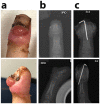Delayed Presentation of Seymour Fractures: A Single Institution Experience and Management Recommendations
- PMID: 31597480
- PMCID: PMC8461200
- DOI: 10.1177/1558944719878846
Delayed Presentation of Seymour Fractures: A Single Institution Experience and Management Recommendations
Abstract
Background: Seymour fractures in children are prone to complications without prompt and appropriate treatment. This study investigated outcomes of Seymour fractures with delayed presentations; specifically, if deep infection predisposed to operative treatment, if antibiotic administration improved fracture healing, and if oral clindamycin had fewer treatment failures than oral cephalexin. Methods: A single-institution retrospective cohort study was performed of patients with delayed Seymour fracture presentations (defined as greater than 24 hours post-injury) between 2009 and 2017. Data collected included demographics, time to presentation, infection on presentation, operative treatment, antibiotic use and duration, fracture union, and complications. Statistical testing used logistic regression and Fisher's exact test, with results reported as P-values (P), odds ratios (ORs), and 95% confidence intervals (CIs). Results: There were 73 patients with delayed Seymour fracture presentations, with mean age of 11.1 years (standard deviation: 2.9), with 56 (77%) males, and median time to presentation of 7 days (interquartile range: 3-17). Deep infection on presentation was a risk factor for operative intervention (OR = 34.4, P = .0001, CI, 5.5-217.2). Antibiotic administration protected against the development of a nonunion or delayed union (OR = 0.11, P = .008, CI, 0.021-0.57). Time to antibiotics did not protect against nonunion or delayed union (OR = 0.77, P = .306, CI, 0.37-1.3). Clindamycin had fewer treatment failures than cephalexin (P = .039). Conclusions: Deep infection is a risk factor for operative treatment of Seymour fractures with delayed presentations. Clindamycin is a better antibiotic choice for Seymour fractures that present in delayed fashion.
Keywords: Seymour fracture; delayed presentation; finger infection; open fracture.
Conflict of interest statement
Figures


References
-
- Seymour N. Juxta-epiphysial fracture of the terminal phalanx of the finger. J Bone Joint Surg Br. 1966;48(2):347-349. - PubMed
-
- Lindor R, Sadosty A. Images in emergency medicine. A jammed finger and bloody nail. Seymour fracture. Ann Emerg Med. 2014;63:656, 677. - PubMed
-
- Abzug J, Kozin S. Seymour fractures. J Hand Surg Am. 2013;38:2267-2270. - PubMed
MeSH terms
Substances
LinkOut - more resources
Full Text Sources

